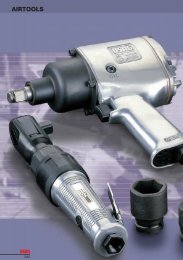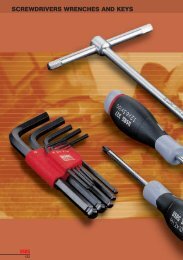Industrial seal self study guide - SKF.com
Industrial seal self study guide - SKF.com
Industrial seal self study guide - SKF.com
You also want an ePaper? Increase the reach of your titles
YUMPU automatically turns print PDFs into web optimized ePapers that Google loves.
fig. 7A<br />
Shaft surfaces must be<br />
smooth and free of nicks<br />
and rough spots<br />
The shaft corners<br />
must be burr-free<br />
.070 - .120 INCH<br />
(1.7B - 3.05mm)<br />
Burr-free radius alternatives<br />
can also be used (fig. 7b).<br />
B<br />
fig. 7B<br />
A dial indicator is used to<br />
measure STBM (fig. 7c).<br />
15-30˚<br />
R.125 INCH<br />
(3.18mm)<br />
Dynamic run-out is also measured<br />
using a dial indicator (fig. 7d).<br />
A<br />
Chapter 7—Shaft<br />
and Bore Conditions<br />
In addition to application parameters and environmental factors, shaft<br />
and bore specifications are important to proper <strong>seal</strong> selection.<br />
Shaft Conditions<br />
Sealing Surface Requirements<br />
<strong>SKF</strong> produces thousands of <strong>seal</strong>s in designs, sizes and lip materials to<br />
meet the most severe operating conditions.<br />
For proper <strong>seal</strong> performance, three factors must be considered:<br />
1. The shaft surface has no machine lead (grooves running<br />
diagonally toward or away from the <strong>seal</strong>ing lip).<br />
2. The entrance edge is chamfered or rounded.<br />
3. The surface finish is 8-17 micro inch Ra (.20 μm to .43μm).<br />
Shaft Requirements<br />
A burr-free chamfer (fig. 7a) or radius (fig. 7b) is required as<br />
illustrated (c = chamfer depth).<br />
Because the <strong>seal</strong>’s inside diameter is difficult to measure and varies<br />
with <strong>seal</strong> designs, the shaft diameter for which the <strong>seal</strong> was designed<br />
is used as the cataloged inside dimension.<br />
Shaft Eccentricity<br />
Two types of shaft eccentricity affect <strong>seal</strong> performance. They are:<br />
• Shaft-to-bore misalignment (STBM)—The amount by which the<br />
shaft is off center, with respect to the center of the bore. This<br />
somewhat <strong>com</strong>mon occurrence is caused by machining and assembly<br />
inaccuracies. To measure, attach a dial indicator to the shaft (between<br />
the shaft and bore), rotate the shaft and read the indicator (fig. 7c).<br />
• Dynamic run-out (DRO)—DRO is the measure of the amount<br />
by which the shaft does not rotate around the true center. The<br />
motion away from the center may be in more than one direction.<br />
Misalignment, in-line boring tolerances, shaft bending, lack of shaft<br />
balance and other manufacturing inaccuracies are <strong>com</strong>mon causes.<br />
To measure, slowly rotate the shaft and calculate total movement<br />
of an indicator attached to the bore and held against the shaft’s<br />
side (fig. 7d).<br />
For specific limitations on both shaft-to-bore misalignment and<br />
dynamic run-out and the total eccentricity (<strong>com</strong>bined STBM and DRO<br />
readings) indicator, refer to the <strong>SKF</strong> Handbook of Seals.<br />
60







